The Desk Detox: 13 Simple 'Deskercises' to Combat Sitting Disease at Work
Ever looked up from your computer and realized you haven't moved in hours? It's a familiar experience for so many of us—and it’s at the heart of “sitting disease,” a term researchers use to describe the health risks that come from staying seated too long. From stiff necks and sore backs to that subtle, restless fatigue at the end of the day, sitting affects us in ways that go far beyond comfort. You might have noticed the impact in your own energy, sleep, or even mood after a long week at your desk. The good news is, our bodies are made to move—and even small actions, done regularly, can spark incredible improvements in how we feel. That’s why deskercises—simple, friendly exercises you can do right at your workspace—are gaining traction in corporate wellness circles and beyond. While scientific research is just starting to catch up to these practical solutions, employers across the US are already rolling out virtual desk yoga and movement sessions, reaching hundreds of employees (Tata Power-DDL, 2024). But even if you’re working solo, you can start your own “desk detox” right now with gentle, accessible movements that suit all ages. These 13 handpicked deskercises don’t require special equipment, just a willingness to listen to your body and fit in a little self-care during your day. Progress counts more than perfection—so let’s take the first step together toward greater comfort and well-being at work.
1. Neck Rolls for Gentle Mobility
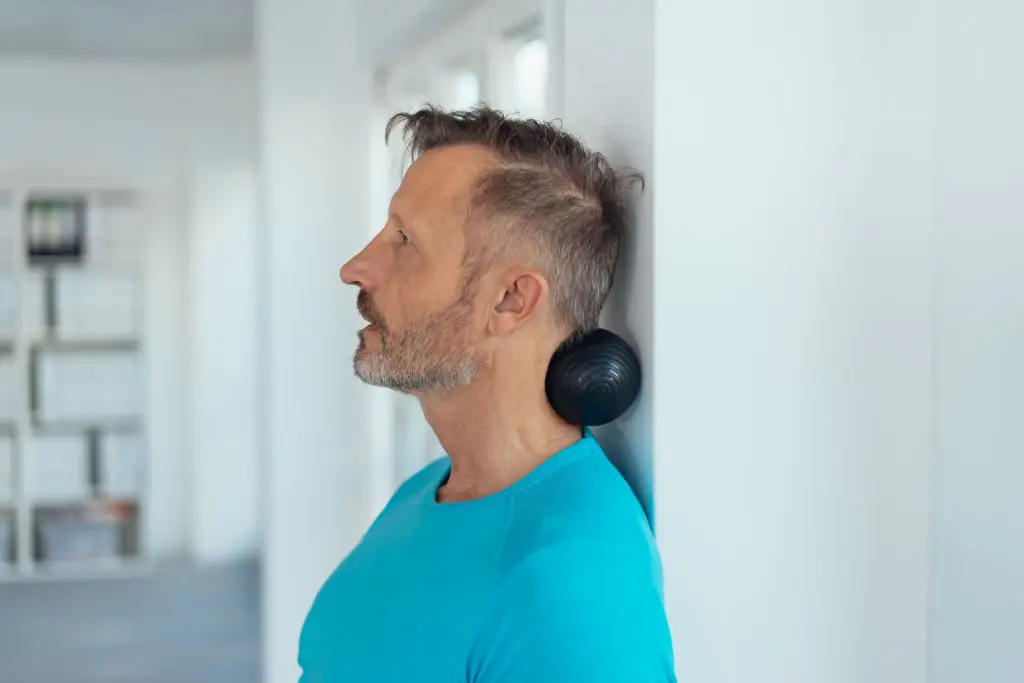
Tech neck is real, and if you spend long stretches reading emails or staring at a monitor, your neck might start to feel like it’s made of stone. Neck rolls can gently loosen tension and restore a feeling of ease. To start, sit tall with your feet planted and shoulders relaxed. Slowly drop your right ear toward your right shoulder, pausing for a moment to notice the gentle stretch. Then, roll your chin down toward your chest, moving your left ear toward your left shoulder, and finally, return to center. Move slowly, taking a full circle in each direction, and let your breath guide you. This is not about pushing into pain—smaller movements are perfectly fine. Even a few rounds, done every hour or so, can keep stiffness at bay and help you reconnect with your posture. If full circles are uncomfortable, try half-circles from shoulder to shoulder. With time, you may notice less tension, more flexibility, and a softer feeling along your neck and upper shoulders—like letting go of a weight you forgot you were carrying.
2. Shoulder Shrugs and Squeezes

Slouching is almost everyone’s secret desk habit, but shoulder shrugs and squeezes offer a gentle reset. Begin by sitting or standing tall. Inhale, lifting your shoulders up toward your ears in a slow shrug, then exhale, letting them drop. Repeat this a few times to melt away upper-body tightness. Next, squeeze your shoulder blades together as if you’re trying to hold a pencil between them, holding for a few seconds before releasing. Try alternating between shrugs and squeezes to build awareness in your upper back and undo that “desk hunch.” Adding slow, deep breaths makes this mini-routine even more effective. You’re not just working your muscles—you’re inviting your brain and nervous system to relax, too. These moves are easy to fit in between calls and can help remind you that a little movement makes a big difference, especially when practiced regularly.
3. Seated Spinal Twist

The mid-back and spine crave mobility, especially after hours of minimal movement. Seated spinal twists offer a way to reawaken your torso. Sit up straight in your chair with both feet flat on the floor. Place your right hand on the outside of your left thigh or chair arm, then gently turn your torso to look over your left shoulder. Keep your hips facing forward and lengthen your spine as you twist. Breathe deeply, pausing for several slow inhales and exhales before slowly returning to center. Repeat on the other side. There’s no need to force the range—let comfort guide your movement. This gentle rotation counteracts desk-related stiffness, engages your core, and feels almost like pressing a refresh button on your posture. With patience, you’ll discover that freedom of movement is always accessible, even within the limits of your chair.
4. Desk Chest Opener

If your shoulders round forward and your chest feels tight, a desk chest opener can remind your body of a more upright, confident stance. While sitting or standing, interlace your fingers behind your lower back or rest your hands on the desk edge behind your hips. Gently squeeze your shoulder blades together while lifting your chin slightly. If you’re standing, add a soft knee bend for better support. As you open your chest, breathe deeply and feel the space expand across your collarbones. This move counterbalances the hunched-forward habit that comes from long computer hours. Even if your shoulders resist at first, over time you may notice improved breathing, a sense of energy, and a more lifted posture. Remember, each small stretch adds up to a brighter, more open presence at work and beyond.
5. Seated Leg Extensions
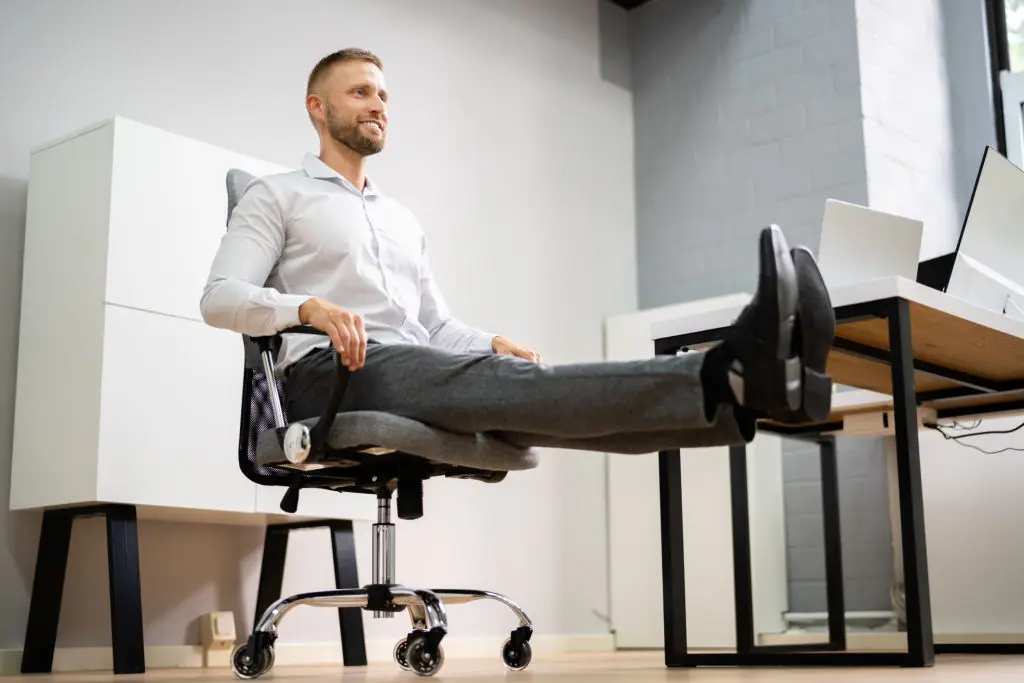
Tired legs are common companions in a desk job, but seated leg extensions offer a discreet, effective way to keep them energized. Sitting upright, extend your right leg out straight, flexing your foot so your toes point upward. Hold for a moment, squeezing your thigh muscles, then gently lower your foot back down. Alternate sides, repeating as comfort allows. This movement wakes up circulation in your thighs and knees and can be done even in business attire or a crowded office. If you want to boost the challenge, try holding each extension for a slow count of five or add a gentle ankle flex and point. Over time, you may notice less stiffness, more alertness, and a subtle sense of strength that grows with each little effort. It’s a great reminder that movement, no matter how small, is a form of self-care.
6. Desk Marches
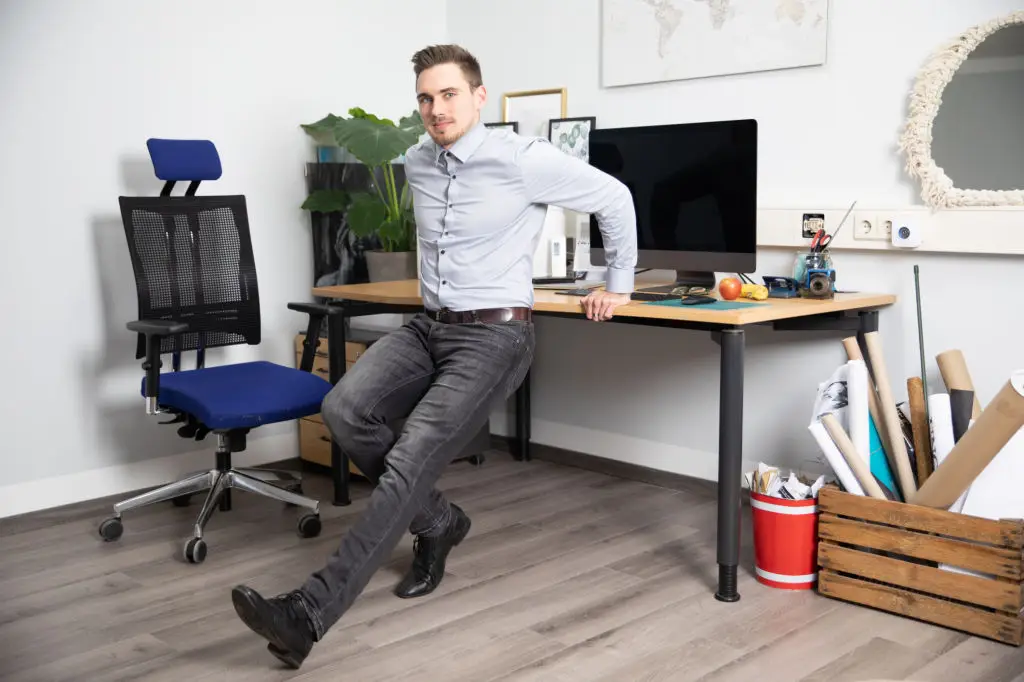
Sometimes, energy drops in the midafternoon are your body's way of hinting it needs to move. Desk marches are a fun, easy way to answer that call without even standing up. Sit with feet flat and posture tall, then lift one knee at a time toward your chest, mimicking a gentle marching motion. If you prefer, you can add arm swings or do these marches standing beside your desk. The movement gets your heart rate up slightly and wakes up sleepy legs. Start with a minute or two, longer if time (and office environment) allows. Desk marches invite fresh circulation and renewed focus. You'll be surprised how quickly your energy rises, like opening a window and letting new air flow through. Marches are also easy to modify for ability or attire—just adjust your speed and intensity for comfort.
7. Ankle Circles and Flexes
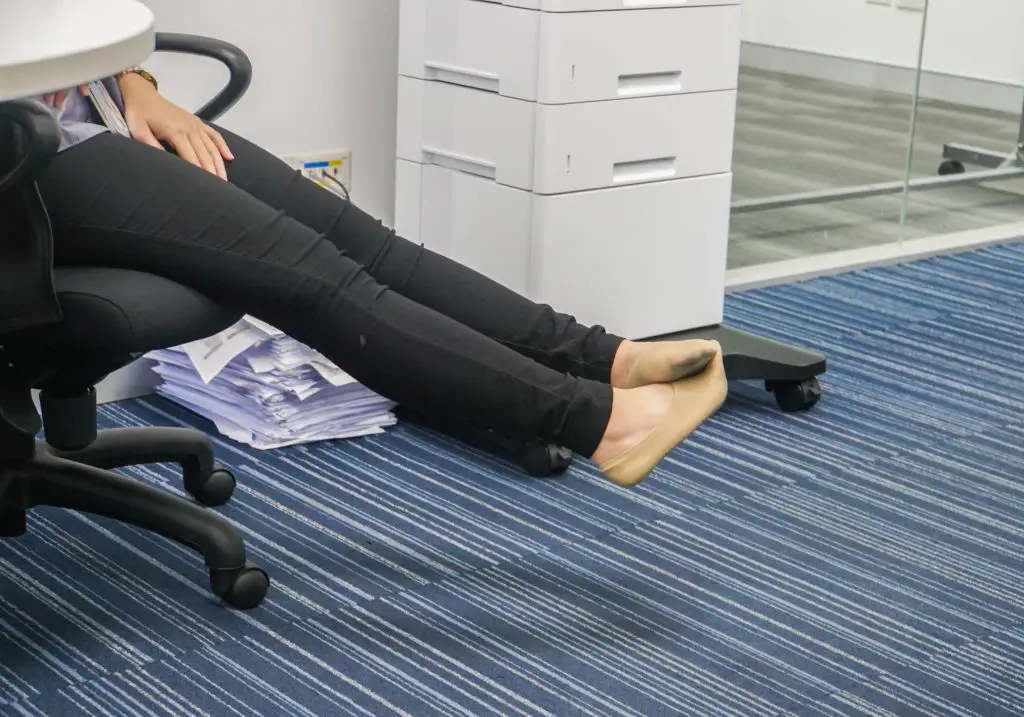
Don’t overlook your ankles and feet—they bear the brunt of long work hours, too! Ankle circles and flexes help prevent stiffness and swelling that can sneak up after a day of sitting. While seated, lift your right foot a couple of inches off the ground and slowly circle your ankle in one direction, then the other. Switch sides, taking time to feel each part of the motion. Next, try pointing and flexing your foot several times, noticing any relief as blood flow increases. These tiny movements can make a big impact, especially for anyone who deals with cold feet or cramped shoes. The best part? You can do ankle stretches while reading, listening in a meeting, or whenever you need a discreet reset. Sometimes the smallest actions are the most powerful for supporting your well-being.
8. Wrist and Finger Stretches

After hours of typing and scrolling, your wrists and fingers deserve a little attention. Try spreading your fingers wide, then making a gentle fist and opening them again. Next, stretch one arm out with your palm facing up, and use your other hand to gently pull your fingers toward the floor, then switch. Rotate your wrists in slow circles, both directions. These stretches help ease tightness from keyboard and mouse use, reducing the chance of nagging aches. Integrating hand and wrist stretches throughout your day is a simple way to show yourself care in an often overlooked area. Bring awareness to each movement and notice whether any tension softens with regular practice.
9. Seated Calf Raises
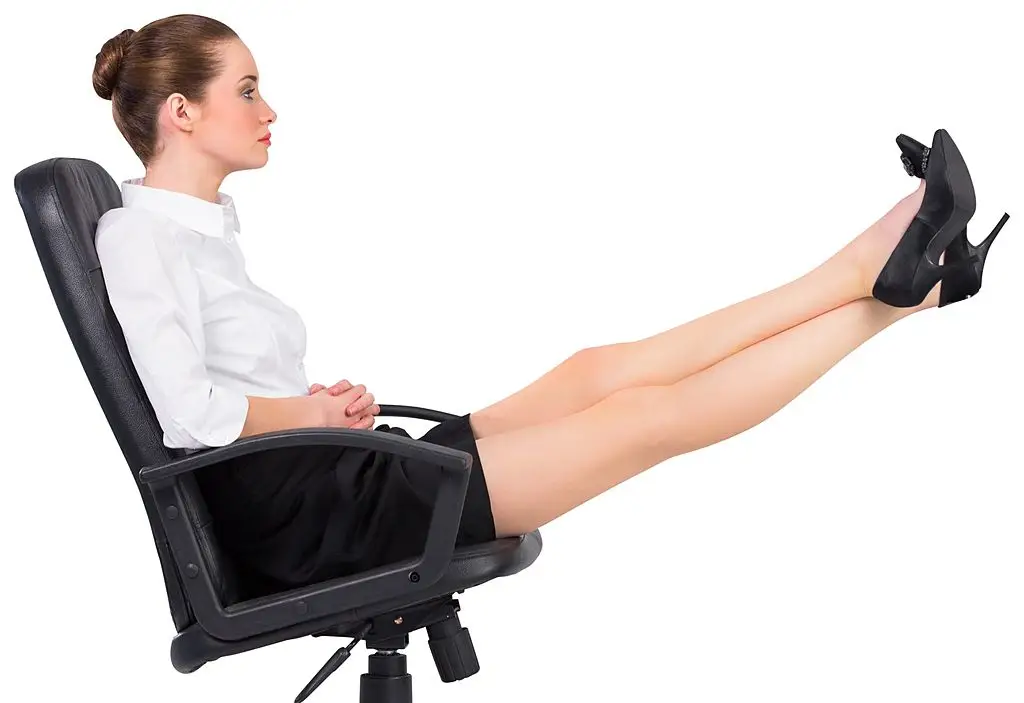
Keeping your lower legs active can go a long way in improving comfort, circulation, and energy at your desk. For seated calf raises, begin with your feet flat on the floor. While seated, lift both heels as high as you can, pressing the balls of your feet into the ground. Pause, then slowly lower your heels. To make this more challenging, try placing your bag, a book, or even a water bottle across your knees for a little extra resistance. Alternate between slow and faster repetitions depending on your mood and available time. This exercise is not only helpful in the office—it works well during long car rides or flights, too. Over time, you’ll likely find your legs and feet feel less heavy, and those restless leg sensations may start to fade.
10. Standing Desk Push-Ups (Modified)
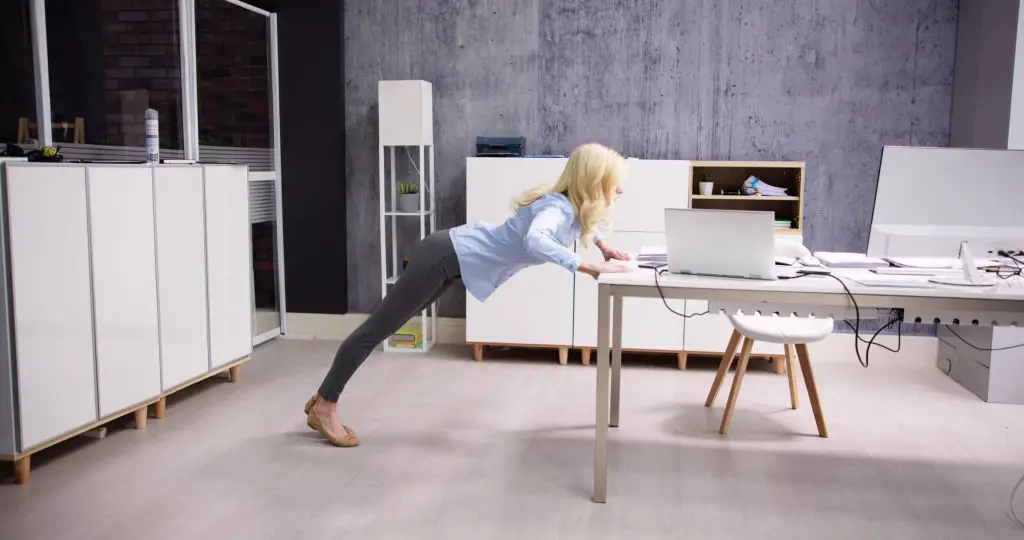
If you have a sturdy desk and enough space, modified push-ups can help wake up your upper body and core. Stand a few feet back from your desk, place your hands on the edge, and walk your feet out behind you to form a straight line from head to heels. Lower your chest toward the desk, keeping elbows close, then press back up. If this feels too tough, the wall is a great substitute. Adjust how far you stand from the desk or wall to make it easier or harder. Aim for several slow repetitions with a focus on steady breathing. Over time, this move can boost functional strength and remind you that a quick burst of effort at work can brighten your mood and build self-confidence—no gym membership needed.
11. Seated Figure Four Stretch
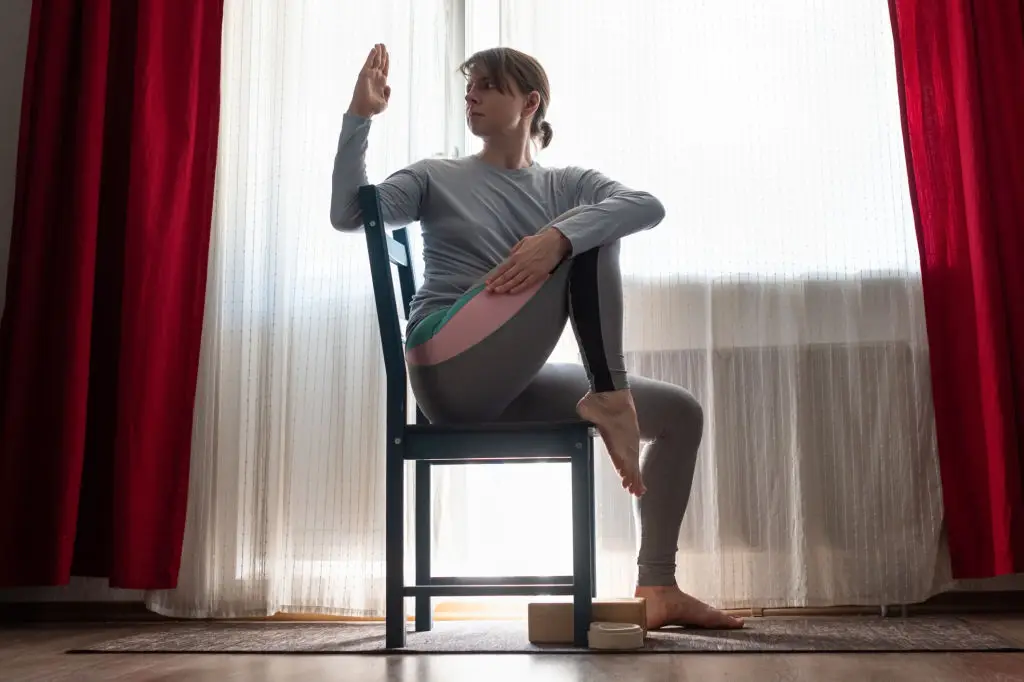
Hips and low backs are often tight after long days in a chair, but the figure four stretch offers sweet relief. Begin sitting with both feet on the floor. Cross your right ankle over your left knee, creating a “figure four” shape. Gently lean forward, keeping your back straight, until you feel a stretch along the outer hip and glute. Hold for several breaths, then switch sides. If flexibility is tricky, try gently pressing your right knee away from you, but only as far as feels comfortable. This move is simple, discreet, and can help restore comfort, especially for anyone who spends lots of time seated. Each stretch is a chance to reconnect with your body—progress is about noticing positive change, one gentle step at a time.
12. Side Bends and Overhead Reaches
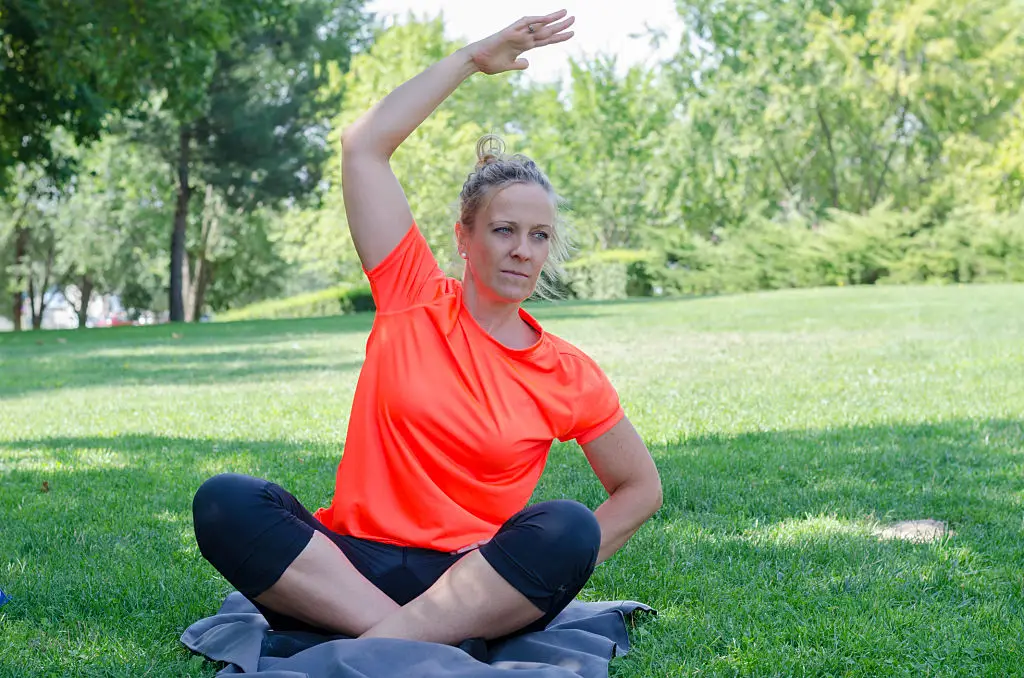
Side bends and overhead reaches are like a wake-up call for the whole body, creating length and letting you reclaim space in your posture. While seated, raise your right arm overhead and gently lean to the left, reaching through your fingertips; switch sides after a few breaths. Alternatively, stretch both arms up and arch slightly back—feel the opening all along your ribs and core. These movements help release tension, especially in the lower back and sides—a common source of desk discomfort. Over time, you may notice easier breathing and a lighter, more open feeling. Find any variation that feels good for your body. If limited by shoulder or back issues, keep the arms lower and focus on side-to-side motion. Your body will thank you for every effort.
13. Seated or Standing Mini-Meditation & Breathwork

Desk life can challenge both body and mind, but a simple mini-meditation can restore clarity and calm. Try sitting comfortably (or stand, if you wish), resting one hand on your belly or heart. Close your eyes or focus softly ahead, and begin to take slow, mindful breaths. Notice the air moving in and out, letting your exhale be a little longer than your inhale. Spend a few moments here, simply noticing any sensations or feelings, without aiming for perfection or “emptying your mind.” Even a single minute helps—breathwork and gentle presence encourage your whole system to shift from tension toward relaxation. For many, this is the most transformative of all deskercises, offering relief that goes deeper than muscle tension alone. It’s a way to remind yourself that well-being is always within reach, just a breath away.
Gentle Movement, Real-World Well-Being

The journey to a healthier, more comfortable workday doesn’t require perfection or fancy equipment—it simply begins with a willingness to move, rest, and notice what your body needs. Deskercises may not grab headline news, but their impact is quietly profound for so many people, one gentle stretch at a time. While we’re still waiting on large-scale studies to quantify all the benefits, early results from workplaces show that even virtual desk yoga routines can touch hundreds of lives, inspiring real change (Tata Power-DDL, 2024). As you integrate these deskercises into your daily rhythm, celebrate each effort, and don’t be discouraged by busy schedules or imperfect moments. Remember, healthy movement is about progress, not pressure. These simple actions—neck rolls, marches, mindful breaths—can boost your energy, soothe discomfort, and support both mind and body through the demands of modern work. Over time, small choices add up to remarkable transformations. Each time you pause for a stretch or a deep breath, you’re choosing your well-being and honoring the wisdom that comes with experience. Stay kind to yourself, explore what feels best, and let every move be a celebration of all your body is capable of each day.
